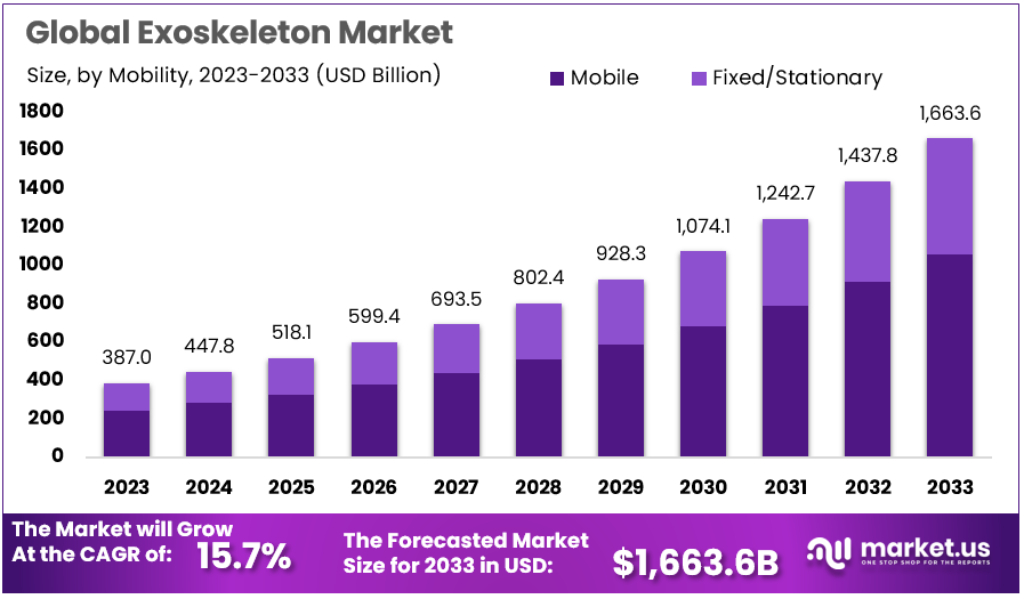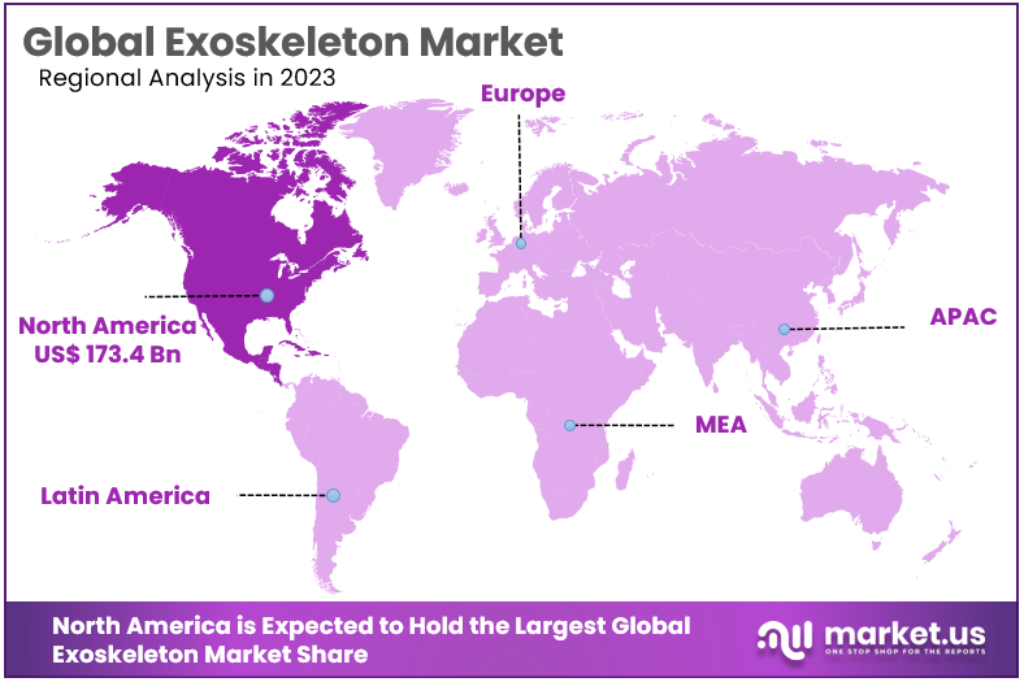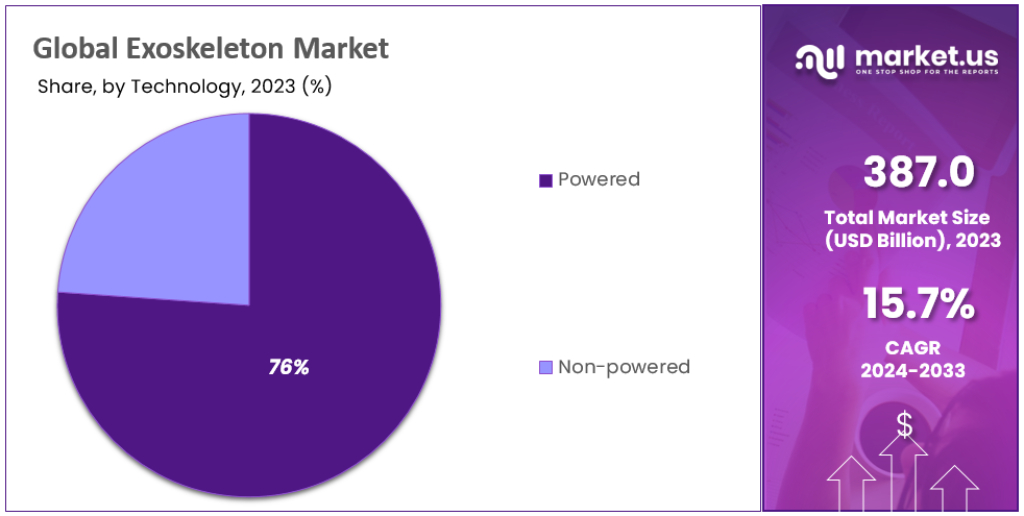New York, Jan. 23, 2024 (GLOBE NEWSWIRE) -- According to Market.us, the Global Exoskeleton Market size is forecasted to exceed USD 1,663.6 Billion by 2033, with a promising CAGR of 15.7% from 2024 to 2033.
The growth of this market is fueled by the growing adoption of medical equipment in diverse sectors such as automotive, defense, and construction. Additionally, there is an increasing global incidence of strokes. The global market is anticipated to witness a rise in the occurrence of Spinal Cord Injuries (SCI). According to the National Spinal Cord Injury Statistical Center (NSCISC), the reported cases of SCI were 17,730, 17,810, and 10,9000 in 2019, 2020, and 2021, respectively. Additionally, 296,000 Americans have experienced SCIs.
Want to Access the Statistical Data and Graphs, Request PDF Sample @ https://market.us/report/exoskeleton-market/request-sample/

Key Takeaway
- By modality, the market is bifurcated into fixed or stationery and mobile. The mobile segment has generated the most revenue in the previous year.
- Based on Technology, the market is segmented into non-powered and powered. The powered technology segment was the top contributor to the exoskeleton market.
- By extremity the market is divided into lower body, upper body, and full body. Among these, the lower body segment emerged as a dominant contributor to the market in 2023.
- When end-use is considered, the market shows segments such as healthcare, industry, and military. The healthcare sector remained the largest contributor to the market, claiming a market share of 51.7%.
- As far as type is concerned, the two segments in the market are soft and rigid.
Factors affecting the growth of the Exoskeleton market
- Technological advancements have been aiding the market expansion of the prefilled syringe market.
- the cumbersome nature of approval processes and regulations discourage the growth of the market.
- Insurance providers have started offering inclusive insurance plans that cover exoskeletons as well. Such diversifying insurance plans have a positive influence on the market.
- High prices of exoskeletons can discourage patients from seeking this particular treatment.
Top Trends in the Global Exoskeleton Market
- The use of exoskeletons in the medical and rehabilitation sector has been a prominent trend. These devices assist individuals with mobility impairments, providing support in walking and improving overall rehabilitation outcomes.
- Industrial and Military Applications: Exoskeletons are increasingly being adopted in industrial settings to enhance worker productivity and reduce the risk of musculoskeletal injuries. Additionally, the military sector is exploring exoskeleton technology for applications like soldier assistance and logistics support.
- Ongoing advancements in materials, sensors, and control systems contribute to the development of more advanced and user-friendly exoskeletons. The integration of artificial intelligence and machine learning is also enhancing the capabilities of these devices.
- The exoskeleton market is witnessing a shift towards more lightweight and wearable designs. Innovations in wearable robotics aim to provide users with a more comfortable and less obtrusive experience, encouraging broader adoption.
- Exoskeletons are increasingly viewed as tools for human augmentation, not only for individuals with disabilities but also for enhancing the physical capabilities of able-bodied individuals in various activities and professions.
Market Growth
Exoskeleton solutions have found widespread adoption across various industries as a means to enhance employee productivity and well-being. Numerous start-ups are specializing in exoskeleton technology and rehabilitation solutions. To strengthen their market shares in the future, industry players are actively engaged in developing innovative product strategies, recognizing the dynamic nature of the exoskeleton industry.
The exoskeleton market has faced obstacles attributed to a dearth of technological advancements and lower per capita incomes in developing nations and emerging economies. In these regions, companies encounter numerous challenges stemming from insufficient funding and limited access to the latest technologies.
Macroeconomic Factors
The overall economic growth of a country or region plays a significant role. During periods of economic expansion, businesses and consumers may have more financial resources to invest in advanced technologies like exoskeletons. Government policies regarding healthcare, disability support, and technological innovation can impact the exoskeleton market. Favorable policies and regulations may encourage market growth, while stringent regulations can pose challenges.
The level of healthcare spending in a country can also affect the adoption of exoskeletons, especially in the medical and rehabilitation sectors. Higher healthcare budgets may lead to increased investment in advanced medical technologies. Further, international trade relationships and agreements can affect the availability and affordability of exoskeleton technologies. Trade barriers or facilitation can impact the market's growth and accessibility.
Regional Analysis
North America has asserted its dominance in the Exoskeleton Market, commanding a substantial 44.8% share and reaching USD 173.4 billion in 2023. This strong position is attributed to various factors, including the rising prevalence of disabilities, increased support from both public and private sectors, heightened collaboration among key industry players, and a growing number of partnerships.
According to data from the Centers for Disease Control and Prevention (CDC), nearly 61 million Americans live with some form of disability, and 13.7% of them experience mobility disabilities. The market's growth is further fueled by factors such as a rapidly expanding geriatric population, availability of investments from both private and public sectors, rising disposable incomes, a significant presence of market players in the region, and an increasing integration of human augmentation technologies in military and industrial verticals.
Furthermore, the Asia-Pacific (APAC) region serves as a central hub for the manufacturing sectors of various industries. Consequently, the region's rapid growth in industrial automation is expected to generate significant demand for exoskeletons.
Gain a deeper understanding of how our report can elevate your business strategy. Inquire here: https://market.us/report/exoskeleton-market/#inquiry

Scope of the Report
| Report Attributes | Details |
| Market Value (2023) | USD 387 Billion |
| Forecast Revenue 2033 | USD 1,663.6 Billion |
| CAGR (2024 to 2033) | 15.7% |
| North America Revenue Share | 44.8% |
| Base Year | 2023 |
| Historic Period | 2018 to 2022 |
| Forecast Year | 2024 to 2033 |
Market Drivers
The exoskeleton market has been significantly influenced by technological advancements in robotics. Progress in electrical and electronic engineering has resulted in improved materials, sensors, actuators, control systems, and software. These innovations have played a crucial role in developing exoskeletons that are more efficient, self-powered, lightweight, simple, and portable. These advancements are essential in the production of user-friendly exoskeletons capable of performing a variety of tasks more effectively.
Market Restraints
Despite substantial advancements in powered lower-limb exoskeletons, challenges persist, especially when navigating sloping or slippery surfaces and executing twisting movements. This limitation can result in fatigue and, in more severe cases, lead to injuries such as skin damage and bone fractures. Consequently, regulatory bodies have implemented stringent approval processes for these devices to guarantee the safety of users, particularly in light of the considerable power generated by the involved actuators.
Market Opportunities
Within the healthcare sector, there is a rising trend of insurance providers extending coverage to robotic devices, including exoskeletons. As an illustration, in Germany, the ReWalk 6.0 personal exoskeleton system earned a listing in the Medical Device Directory, rendering it eligible for insurance procurement. This increasing endorsement from insurance companies presents a noteworthy opportunity for the exoskeleton market, enhancing accessibility for individuals in need of these devices.
Get Immediate Delivery | Secure Your Copy of This High-Quality Research Report Now https://market.us/purchase-report/?report_id=12588
Report Segmentation of the Exoskeleton Market
Mobility Insight
The mobile sector played a major role in driving the exoskeleton market in 2023, commanding a prominent position with a market share exceeding 63.56%. The growth of this segment is credited to its versatility and diverse applications across industries such as healthcare, military, and industrial sectors. Mobile exoskeletons provide advanced mobility and physical assistance, contributing to their increased adoption in activities involving substantial physical labor or assistance in movement.
Technology Insight
In 2023, powered technology emerged as the dominant force in the exoskeleton market, claiming a considerable share of over 76.1%. This substantial market presence is credited to the advanced features of powered exoskeletons, including heightened strength, endurance, and precision, which are highly sought after in diverse sectors like healthcare, military, and industrial applications. Powered exoskeletons, equipped with motors, actuators, and sophisticated control systems, offer substantial assistance and augmentation of human capabilities, contributing to their widespread adoption.
Extremity Insight
In the exoskeleton market of 2023, the lower body category emerged as a leading segment, securing a significant share of over 43.6%. This segment's dominance is primarily driven by the increased need for lower body exoskeletons in various applications, including mobility aid, rehabilitation, and industries with physically demanding tasks. These exoskeletons are specifically crafted to provide support and amplify the strength and stamina of the legs and lower back, making them well-suited for activities that entail prolonged standing, walking, or lifting.
End-Use Insight
In 2023, the exoskeleton market was notably led by the healthcare sector, securing a substantial share of over 51.7%. This prominent market position is attributed to the growing utilization of exoskeletons in rehabilitation, supporting patients with mobility challenges, and assisting the elderly population. The healthcare industry's commitment to delivering advanced care and enhancing the quality of life for patients fuels the demand for these devices, which find applications ranging from physical therapy to aiding in daily activities.
Type Insight
In 2023, the soft exoskeletons contributed the most to the market. Soft exoskeletons are more common in healthcare for several reasons, primarily due to their design, flexibility, and intended applications. These exoskeletons are made from flexible materials such as fabric, textiles, or soft plastics, making them more comfortable to wear compared to rigid exoskeletons. Further, such exoskeletons are designed to mimic the natural movements of the human body. Their flexibility allows for a more natural range of motion, making them suitable for applications in rehabilitation and assisting individuals with mobility challenges.
Recent Development of the Exoskeleton Market
- In June 2023, Sarcos Robotics rounded out the product releases with the Guardian XO Max, targeting military and first responders, offering superhuman strength and endurance. This flurry of launches underscores the industry's commitment to innovation, diverse applications, and addressing specific user needs across medical, industrial, and defense sectors.
- In July 2023, Ottobock launched the Paexo, specifically designed for industrial workers to reduce fatigue and enhance productivity.
- In September 2023, ReWalk Robotics unveiled the ReWalk ONE, emphasizing lightweight and comfortable design for paraplegics. Bionic Power Systems entered the market in August with the C-Leg 7, an exoskeleton catering to amputees, boasting enhanced responsiveness and intelligence.
- In October 2023, Ekso Bionics introduced the EksoNR, targeting the rehabilitation and gait training sector with a focus on affordability and accessibility.

Market Segmentation
Mobility
- Fixed/Stationary
- Mobile
Technology
- Non-Powered
- Powered
Extremity
- Lower Body
- Upper Body
- Full Body
End-use
- Healthcare
- Industry
- Military
Type
- Soft Exoskeleton
- Rigid Exoskeleton
By Geography
North America
- US
- Canada
Europe
- Germany
- France
- The UK
- Spain
- Italy
- Russia
- Netherland
- Rest of Europe
Asia Pacific
- China
- Japan
- South Korea
- India
- New Zealand
- Singapore
- Thailand
- Vietnam
- Rest of APAC
Latin America
- Brazil
- Mexico
- Rest of Latin America
Middle East & Africa
- South Africa
- Saudi Arabia
- UAE
- Rest of MEA
Get PDF Sample for Technological Breakthroughs @ https://market.us/report/exoskeleton-market/request-sample/
Competitive Landscape
The competitive landscape of the global exoskeleton market is characterized by a mix of established players and innovative startups striving for market dominance. Industry leaders such as Ekso Bionics, Cyberdyne Inc., and Rewalk Robotics are leveraging their extensive experience to offer a range of exoskeleton solutions across medical, industrial, and military applications. Startups like SuitX and REX Bionics are bringing fresh perspectives and technological advancements, emphasizing lightweight designs and user comfort. Strategic collaborations and partnerships are prevalent, with companies joining forces to combine expertise and accelerate product development. The market is dynamic, with a focus on technological innovation, regulatory compliance, and expanding market reach, driven by the increasing adoption of exoskeletons in diverse sectors worldwide.
Market Key Players
- Hocoma
- Ekso Bionics
- Suit X (U.S. Bionics Inc.)
- Lockheed Martin Corporation
- RB3D
- Rex Bionics Plc.
- Cyberdyne Inc.
- Atoun Inc.
- Wearable Robotics Srl
- ReWalk Robotics Ltd.
- Bionik Laboratories Corp.
- ActiveLink (Panasonic Corporation)
- Other Key Players
Browse More Related Reports
- Mammography Market size is expected to be worth around USD 6,165 Million by 2032 from USD 2,500 Million in 2022
- Urinalysis Market size is expected to be worth around USD 8.4 Billion by 2032 from USD 4 Billion in 2022
- Autoimmune Disease Diagnostics Market is valued at USD 5.3 Bn and is expected to reach USD 10.3 Bn in 2032
- Live Cell Imaging Market was valued at USD 2.8 Billion and is expected to grow to USD 6.7 billion in 2032
- ADME Toxicology Testing Market size accounted for USD 8.3 billion and is expected to grow to around USD 26.2 billion in 2032
- Personal Health Record Software Market Size is anticipated to reach approximately USD 21.7 Billion by 2033, compared to the 2023 valuation of USD 9.2 Billion
- Behavioral Health Market size is expected to be worth around USD 227.5 Bn by 2032 from USD 140.1 Bn in 2022
- Teleradiology Market Size is anticipated to reach approximately USD 10.1 Billion by the year 2033, up from USD 2.9 Billion in 2023
- Acute Ischemic Stroke Therapeutics Market size is expected to be worth around USD 14.0 Billion by 2032 from USD 8.5 Billion in 2022
- Antibody Drug Conjugates Market accounted for USD 7.2 billion and is expected to grow to around USD 34.7 billion in 2032
About Us:
Market.US (Powered by Prudour Pvt Ltd) specializes in in-depth market research and analysis and has been proving its mettle as a consulting and customized market research company, apart from being a much sought-after syndicated market research report-providing firm. Market.US provides customization to suit any specific or unique requirement and tailor-makes reports as per request. We go beyond boundaries to take analytics, analysis, study, and outlook to newer heights and broader horizons.
Follow Us on LinkedIn
Our Blog:
